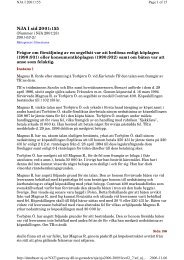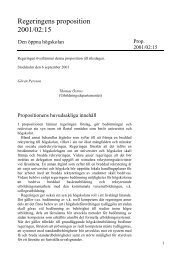A Study of the ITU-T G.729 Speech Coding Algorithm ...
A Study of the ITU-T G.729 Speech Coding Algorithm ...
A Study of the ITU-T G.729 Speech Coding Algorithm ...
You also want an ePaper? Increase the reach of your titles
YUMPU automatically turns print PDFs into web optimized ePapers that Google loves.
Open<br />
MASTER THESIS<br />
Datum - Date Rev Dokumentnr - Document no.<br />
04-09-28 PA1<br />
Several methods and sophisticated algorithms have been developed for <strong>the</strong> evaluation<br />
<strong>of</strong> <strong>the</strong> QoS. PSQM (<strong>ITU</strong> P.861), PAMS (BT) and PESQ are some examples [23].<br />
The Resource Reservation Protocol (RSVP) is a protocol which allows <strong>the</strong> Internet to<br />
support QoS. RSVP, which is part <strong>of</strong> <strong>the</strong> Internet Integrated Service (IIS) model, contains<br />
<strong>the</strong> ability to reserve resources along a path from <strong>the</strong> source to <strong>the</strong> destination, which<br />
<strong>the</strong>n in turn allows routers, enabled by RSVP, to schedule and prioritize packets, which<br />
guarantees <strong>the</strong> QoS.<br />
IP-IPv6, which succeeded IPv4, inherently supports QoS. However, in contrast to IPv4,<br />
whose packet header requires a mere 20 bytes, <strong>the</strong> packet header <strong>of</strong> IPv6 necessitates<br />
40 bytes, which doubles <strong>the</strong> overhead and may thus result in a greater latency which is<br />
especially troubling for vocoders with diminutive packets. However, header compression<br />
schemes are existent which are able to, at least partially, <strong>of</strong>fset <strong>the</strong> extended header overhead.<br />
4.5.1 Packet Loss and Jitters<br />
If a router receives too many packets due to network congestions, some <strong>of</strong> <strong>the</strong> packets<br />
may be dropped out, known as packet loss. In general, packet loss has a substantial effect<br />
on <strong>the</strong> quality <strong>of</strong> <strong>the</strong> received audio/video and packet losses in excess <strong>of</strong> 10 percent<br />
are regarded as intolerable. Since voice transmissions are extremely time sensitive, regular<br />
retransmission instruments which are based on TCP appear inappropriate. <strong>Speech</strong><br />
interpolation is one approach commonly used for packet-loss compensation. With interpolation,<br />
losses which incur during unvoiced speech segments are corrected through packet<br />
repetition, while losses during voiced speech are repaired through <strong>the</strong> use <strong>of</strong> pitch-cycle<br />
waveform repetition.<br />
Even in <strong>the</strong> case that packets are transmitted at even intervals, <strong>the</strong>y may reach <strong>the</strong> recipient<br />
with uneven intervals. Such a gap <strong>of</strong> arrival time is known as jitter. Jitters are generally<br />
<strong>the</strong> result <strong>of</strong> network congestions, because routers have to handle a great number<br />
<strong>of</strong> packets transmitted from many o<strong>the</strong>r hosts. Since jitters affect <strong>the</strong> timing <strong>of</strong> audio/video<br />
playback, also <strong>the</strong> quality <strong>of</strong> received audio and video is decreased. The removal <strong>of</strong> jitters<br />
requires <strong>the</strong> collection <strong>of</strong> packets, which subsequently have to be stored long enough so<br />
that <strong>the</strong> slowest packet will arrive and be played in <strong>the</strong> correct sequence. A jitter buffer<br />
temporarily stores arriving packets <strong>the</strong>reby minimizing delay variations. Packets that arrive<br />
too late are discarded [21].<br />
4.5.2 Latency<br />
Latency is an essential factor in IP performance, and reducing or mitigating <strong>the</strong> effects<br />
<strong>of</strong> latency is an important aspect <strong>of</strong> network performance engineering. Latency, which is<br />
defined as <strong>the</strong> time delay incurred in speech by <strong>the</strong> IP Telephony system, is generally measured<br />
in milliseconds from <strong>the</strong> moment that <strong>the</strong> speaker utters a sound until <strong>the</strong> listener<br />
actually hears <strong>the</strong> sound. This is known as one-way latency, while round-trip latency is <strong>the</strong><br />
sum <strong>of</strong> <strong>the</strong> two one-way latency figures which make up a telephone call. The round-trip<br />
latency for domestic calls over <strong>the</strong> PSTN within <strong>the</strong> continental United States, is, for instance,<br />
virtually always under 150 milliseconds. At <strong>the</strong>se levels, users are unable to notice<br />
<strong>the</strong> latency. By contrast, international calls, particularly <strong>the</strong> ones carried via satellite, may<br />
44 (78)





